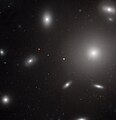Slika:NGC 4874 HST.jpg

Velikost tega predogleda: 578 × 600 točk. Druge ločljivosti: 231 × 240 točk | 463 × 480 točk | 740 × 768 točk | 987 × 1.024 točk | 1.973 × 2.048 točk | 3.864 × 4.010 točk.
Izvorna datoteka (3.864 × 4.010 točk, velikost datoteke: 5,95 MB, MIME-vrsta: image/jpeg)
Zgodovina datoteke
Kliknite datum in čas za ogled datoteke, ki je bila takrat naložena.
| Datum in čas | Sličica | Velikost | Uporabnik | Komentar | |
|---|---|---|---|---|---|
| trenutno | 13:55, 20. september 2011 |  | 3.864 × 4.010 (5,95 MB) | Jmencisom |
Uporaba datoteke
Datoteka je del naslednje 1 strani slovenske Wikipedije (strani drugih projektov niso navedene):
Globalna uporaba datoteke
To datoteko uporabljajo tudi naslednji vikiji:
- Uporaba na ar.wikipedia.org
- Uporaba na arz.wikipedia.org
- Uporaba na ast.wikipedia.org
- Uporaba na az.wikipedia.org
- Uporaba na be.wikipedia.org
- Uporaba na ce.wikipedia.org
- Uporaba na cs.wikipedia.org
- Uporaba na de.wikipedia.org
- Uporaba na diq.wikipedia.org
- Uporaba na en.wikipedia.org
- Uporaba na et.wikipedia.org
- Uporaba na eu.wikipedia.org
- Uporaba na fr.wikipedia.org
- Uporaba na hr.wikipedia.org
- Uporaba na it.wikipedia.org
- Uporaba na ja.wikipedia.org
- Uporaba na kk.wikipedia.org
- Uporaba na ko.wikipedia.org
- Uporaba na mk.wikipedia.org
- Uporaba na nl.wikipedia.org
- Uporaba na pl.wikipedia.org
- Uporaba na ru.wikipedia.org
- Uporaba na sk.wikipedia.org
- Uporaba na tt.wikipedia.org
- Uporaba na uk.wikipedia.org
- Uporaba na uz.wikipedia.org
- Uporaba na www.wikidata.org
- Uporaba na zh.wikipedia.org
